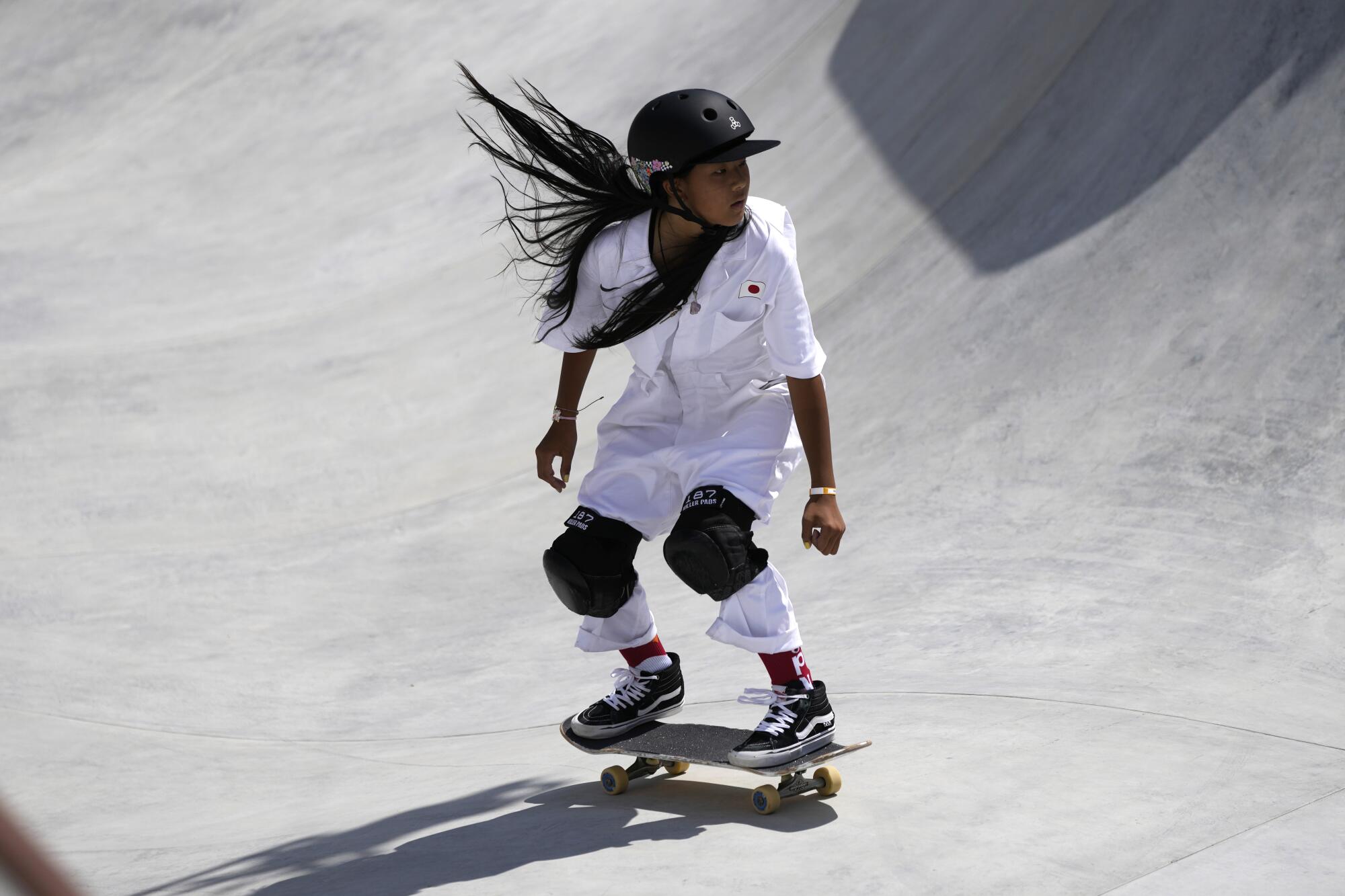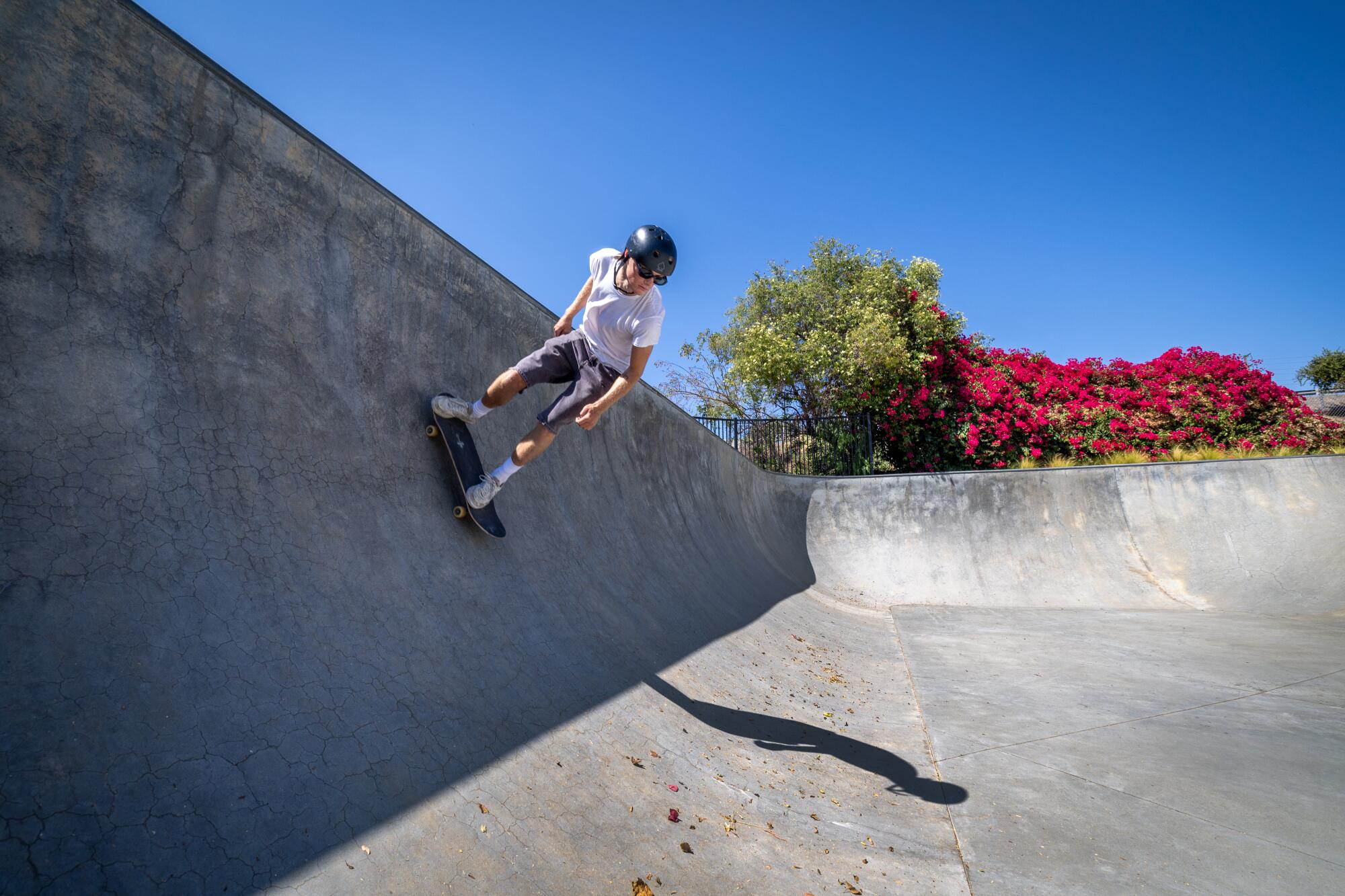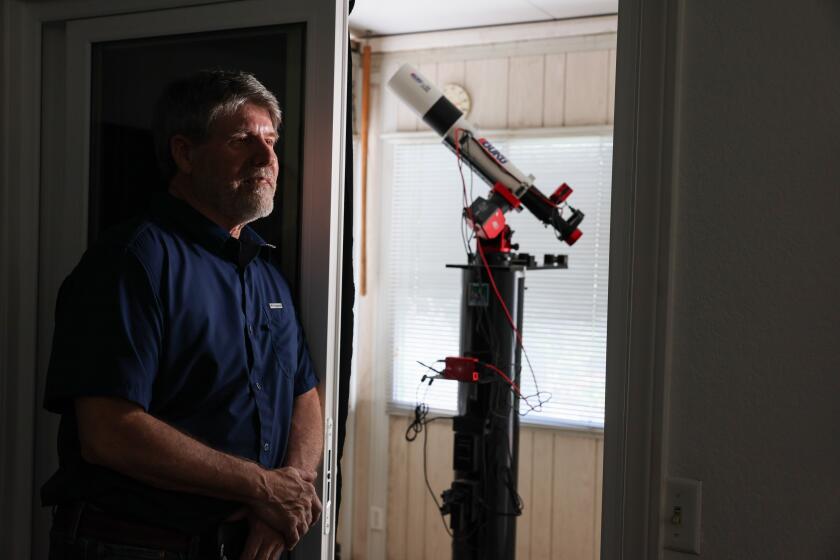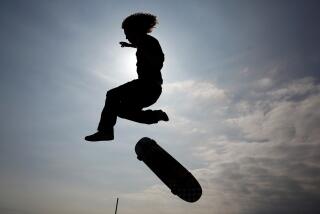Greyson Godfrey soars high over the coping at Etnies Skate Park Lake Forest. (Allen J. Schaben / Los Angeles Times)
Skateboarders call it âpumping,â and itâs a skill that both Olympic medalists and aspiring thrashers use to build launch speed from what seems like thin air.
But what separates the steeziest pro from the sketchiest beginner is the yearsâ worth of practice it takes to develop the know-how to execute the cleanest pump â or at least that was the case until now.
In a paper published Monday in the journal Physical Review Research, scientists have revealed the secret of achieving serious airtime.
A skateboarder rides the bowls at Etnies skatepark in Lake Forest. (Allen J. Schaben / Los Angeles Times)
With a bit of coding, researchers were able to describe the optimal technique for pumping â a tactic where skateboarders crouch down low momentarily and then push their body upright on inclines. To get the highest jump, they need to do it once as they descend into the bowl, and then again as they shoot back up toward the sky.
The trick is knowing when and where to execute the maneuver.
With a rare star explosion expected any day now, astrophysicists are relying on a community of hobbyists with backyard telescopes to tell them when it erupts.
âPumping is the foundation of skateboarding in skate parks,â said professional skater Haden McKenna, during a morning session at the Venice Beach Skatepark. âYou build off of that and learn tricks. Then the pumping just becomes something in the back of your brain.â
However, the likeliest users of the researchersâ perfect pump equation are non-humans.
After skateboardingâs Olympic debut at the Tokyo Games, a research arm of the Japanese government reached out to Shigeru Shinomoto, a scientist at the Advanced Telecommunications Research Institute International in Japan. The organization had wondered if it was possible to build a skateboarding robot that could compete in the X Games.
The robot is still a ways off â right now itâs more like a toy that rides back and forth on a mini half-pipe â but the researchers discovered that the mechanics for good skateboarding technique can be surprisingly simple (well, at least compared to the complex fluid dynamics and neuroscience that theyâre normally working on).

âItâs just this cute little project which became much bigger than we expected,â said Florian Kogelbauer, an author on the paper and a mechanical engineering professor at the public university ETH ZĂźrich. âPeople like it â itâs a fun topic. Itâs easy to explain, but some serious math and computational work went into it.â
To test their calculations, study authors recruited an expert skater with over a decade of experience, and a novice with just two years under their belt. They told the skaters to catch as much air as possible on a half-pipe erected in a research lab.
The result: The pro much more closely matched their calculated optimal motion than the amateur. (Ideally the skater would pop up instantaneously, but the researchers conceded that humans lack the unlimited muscle strength to do this â plus it would send the skater flying off their board.)
Example of skateboarder âpumping.â (Daniel Callan)
âThe experiment seems to agree well,â said Frank Feng, a mechanical engineering professor at the University of Missouri who was not involved with the paper, but studied similar motions in half-pipe snowboarding.
For tourists, a summer visit to Death Valley is a brief flirtation with deadly heat. For full-time residents though, its a way of life.
Feng said the simple physics model gets researchers most of the way there, then the computer optimization is able to account for complexities that the physics equations canât handle.
While the study was mostly just for fun, it snowballed into a fairly big project, and ended up getting published in one of the worldâs premier physics journals. Part of the reason is that it may have some serious implications for how to get robots to move effectively without face-planting all the time.
It could help human skateboarders, too. Feng said the results could be used as a straightforward guide to help skateboarders train.
However, some question whether skaters would be able to use the information in the moment.
âThis graph, showing the mass going up, is very helpful for somebody that can understand that,â said pro skater McKenna, who was not involved in the research. âBut when youâre teaching kids and youâre trying to teach somebody thatâs focused in the moment of skateboarding, theyâre not going to be able to bring math into the equation.â
Also, out in the complex terrain of the park, the technique gets a bit more nuanced than a simple model the physicists developed. You need to flow as âone with the wall,â said McKenna. âLike what Bruce Lee says, âBe like water.ââ

While the researchersâ optimal solution may not always be the best suited for real-world conditions, it does help to illustrate the physics behind the technique.
Studio Gutierrez, who teaches skateboarding as a sports instructor to middle schoolers in the Los Angeles Unified School District, finds understanding the science helpful for new skaters. âI explain it to them in physics motions,â he said. âThe more motion, the faster you go, the higher you get.â
The physics works similarly to how ice skaters increase the speed of their spinning in the Winter Olympics, said Kogelbauer. They start out spinning slow with their limbs extended outward. Then, they tuck their arms and legs in, causing them to spin faster.
Skateboarders also gain speed by using this technique on curved surfaces.
When a skateboarder hits the circular section of the half-pipe, they start crouched down, positioning their center of mass further from the center of rotation above their head. As they climb the curved ramp, they pop up and bring their center of mass closer to the center of rotation, and they speed up.
The Jurupa Valley City Planning Commission has requested further study on a development that potentially threatens one of the oldest plants in the world.
While the pumping paper is one of the first to capture the physics of pumping, its authors arenât the only ones studying the motion of skateboarding.
Google has also taken a stab at a more complex understanding with its Project Skate. Itâs using AI to identify different tricks and motions â but AI requires a lot of computing power that many researchers who arenât Google donât have access to.
âThey have [essentially] unlimited resources. If they want to, they can take a new server farm and then run trajectories as much as they want.â said Kogelbauer. âThatâs what Google does. Weâre not Google.â
If youâd like to study pumping physics on your own, you can tune in to the Paris Olympics. The women skateboarders are scheduled to compete in the park event (as opposed to the street event, which has fewer curved surfaces for pumping) Tuesday morning. The men are scheduled for Wednesday.
McKenna has always seen skating more as an art form and community than a sport, but heâs stoked to watch nonetheless. âWhen I was a kid, which doesnât seem that long ago, skateboarding was a crime, literally,â he said. âNow weâre winning gold medals in the Olympics.â










